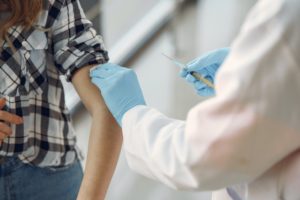 Although it is a good sign more than one million people registered their interest voluntarily on May 26, the second phase of the AstraZeneca vaccination is only scheduled between Jun 7 and Jul 27. This is only applicable for the first dose of the vaccine.
Although it is a good sign more than one million people registered their interest voluntarily on May 26, the second phase of the AstraZeneca vaccination is only scheduled between Jun 7 and Jul 27. This is only applicable for the first dose of the vaccine.
When I entered the AstraZeneca registration webpage via https://www.vaksincovid.gov.my/, there are not many vaccination centres (PPVs) to choose from – only two PPVs are available in Kuala Lumpur.
After anticipating my appointment date and time via MySejahtera for two days, finally, I received confirmation on May 28. However, I only could receive vaccination in two months (Jul 27).
Although the current administration has an ambitious target administering 150,000 doses of the Covid-19 vaccine per day by setting up more mega PPVs, the large crowds at four PPVs in the Klang Valley in mid-May poses concern among the public.
It is obvious when Malaysia recorded 4,113 new Covid-19 cases on May 14. Some citizens who were not registered for the AstraZeneca vaccine were “trying their luck” by walking in at the World Trade Centre Kuala Lumpur (WTCKL) the next day (May 15).
On the other hand, some citizens who managed to secure vaccination appointment during the first AstraZeneca opt-in registration on May 2 arrived much earlier than their scheduled time. Instead of arriving half an hour before their vaccination appointment time (i.e., arrive at 5.30 pm for 6 pm appointment), there were a significant number of people who were there hours earlier (i.e., arrive at 2 pm for 6 pm appointment).
Respecting the overcrowding situation in some PPVs earlier, former minister Tan Sri Rafidah Aziz recommended the current administration to use multi-purpose halls as providing convenience for the district health officers to monitor the vaccination coverage in a particular district. The residents also do not have to cross borders to receive the vaccination.
As of May 30, National Covid-19 Immunisation Programme (CITF) Coordinating Minister Khairy Jamaluddin stated that three more mega PPVs placed in Selangor and two more in Kuala Lumpur.
For instance, The Mines, Puncak Alam UiTM and Setia City Convention Centre are three additional mega PPVs in Selangor. Kuala Lumpur Convention Centre and Bukit Jalil National Stadium are the other two mega PPVs in Kuala Lumpur.
Although Khairy is committed in arranging small PPVs, drive-through PPVs and mobile PPVs as part of the Covid-19 vaccination efforts, the National Covid-19 Immunisation Programme (PICK) Handbook indicated a relatively low number of PPVs allocated in states such as Kelantan, Terengganu, Pahang, Johor, Sabah and Sarawak.
To address the insufficient PPVs issue, the current administration could consider renting empty community halls, universities, hotels and other appropriate facilities in different zones of each constituency. This would help respective owners to weather the health crisis while ensuring standard operating procedures (SOPs) is observed at all times.
Although the Ministry of Federal Territories has aimed to provide 40 mobile trucks to conduct “mobile truck” vaccination, it is time for the current administration to set up more mobile clinics outside of Federal Territories (Kuala Lumpur, Putrajaya and Labuan). This would provide the convenience for residents in receiving the vaccination.
 As more than a third of the population in East Malaysia continue to live beyond 5km of any kind of health facility, there is a crucial need to enhance coordination between the federal government and state governments. So, the vaccines could be distributed according to the population needs and logistical requirements.
As more than a third of the population in East Malaysia continue to live beyond 5km of any kind of health facility, there is a crucial need to enhance coordination between the federal government and state governments. So, the vaccines could be distributed according to the population needs and logistical requirements.
With the help from the federal government and Covid-19 Vaccine Supply Access Guarantee Special Committee (JKJAV), both the Sabah and Sarawak state governments could provide flying doctor services in the remote areas of both states. It would shorten the delivery times of vaccines and allow rural citizens in both states to inoculate as soon as possible.
It is a good move for the current administration to have 500 general practitioner (GP) clinics administering Covid-19 vaccines from Jun 15 and 1,000 private clinics designated as PPVs by Jun 30. However, only 184 out of the 2,500 GPs have begun administering the vaccines, according to Datuk Dr Subramaniam Muniandy, President of Malaysian Medical Association.
This is quite a disappointment, as more GPs should come forward to assist government in this inoculation drive to achieve herd immunity, now that the government has designated private clinics as PPVs.
Besides medical, nursing and pharmacy students, vaccine corps could be formed by community grassroots, comprising retired or unemployed clinicians. They could deliver vaccine shots, monitor individuals who had just vaccinated or inject second doses for the vaccines to be fully effective.
For instance, students in the vaccine corps could administer vaccines in low-cost housing flats and shelters for the homeless and victims of domestic violence. They should also be provided transportation to vaccination sites or take doses directly to homebound elders who might have difficulty travelling from one place to another.
By mobilising vaccine corps on a large scale, the current administration could accelerate the nationwide roll-out of Covid-19 vaccines, besides ensuring doses are distributed equitably to every Malaysian citizen.
As the current administration plans to station 15,000 officers in 950 vaccination centres throughout the country, some can be allocated to the east coast of Peninsular Malaysia and East Malaysia, giving extra helping hands in vaccine injection for the benefits of residents in less-developed Malaysian states.
Moreover, the government could consider Indonesia’s approach – collaborating with private companies such as Grab to provide more drive-through PPVs across Malaysia.
For ensuring successful implementation, a real whole-of-society effort would be required, going beyond the auspices of the Ministry of Science, Technology and Innovation (MOSTI), Ministry of Health Malaysia (MOH) and the National Security Council (NSC).
This would involve different stakeholders such as non-governmental bodies, corporations, embassies, international organisations, schools, universities and health care providers.
By marking and including all the semi-urban, rural and interior areas onto the map, Village Community Development Councils (MPKK), Community Development Officers (PPM) and resident committees could monitor the vaccination coverage thoroughly in their respective communities.
In a nutshell, now is the time for the current administration to provide multiple types of PPVs across the whole country, ensuring Malaysia inoculate at least 80 per cent of the population by year-end.
Amanda Yeo is Research Analyst at EMIR Research, an independent think tank focused on strategic policy recommendations based on rigorous research. This article are the views of the author and may not necessarily reflect the views of this publication.
